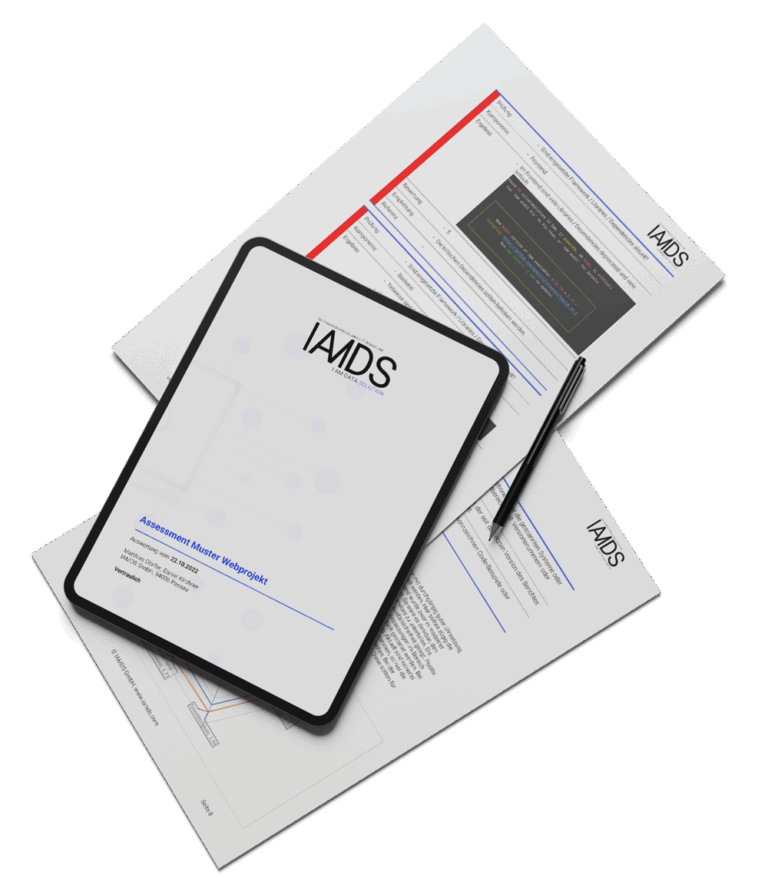Technically tested.
Comprehensive auditing for your project
Whether software, IT infrastructure, ML / AI models, user experience or technical due diligence - our audits provide clarity about risks, optimization potential and future viability. We deliver reliable analyses that combine technical substance with strategic added value.
How do we conduct an audit?
Every audit starts with a non-binding initial meeting in which we define your goals, systems and the appropriate audit framework together. Our experts then analyze your software, infrastructure or AI solutions using proven tools and methods - independently, in-depth and practical.
Based on the analysis, you receive a structured report with all the results, clearly prioritized risks and concrete recommendations for action - understandable for technology and management. In a final meeting, we explain the key findings and support you in deriving the next steps - from quick wins to a strategic roadmap.

Software-Audit
- Code quality:
Check for readability, maintainability, modularity and compliance with best practices and coding standards.
- Security:
Identification of security vulnerabilities in the source code, evaluation of authentication and authorization mechanisms and testing for vulnerabilities such as SQL injection, XSS or insecure data processing.
- Architecture:
Analysis of the software architecture for stability, modularity, expandability and technological sustainability.
- Scalability:
Evaluation of whether the application is designed for growing user numbers and increasing data volumes, including recommendations for optimization.
- Maintainability:
Investigation of how easily and efficiently the software can be maintained, adapted and expanded during operation, including documentation quality and test coverage.
IT infrastructure audit (cloud readiness check)
- On-Prem:
Analysis of the existing physical infrastructure, server landscapes, networks and their efficiency, security and degree of modernization.
- Cloud:
Evaluation of current cloud environments (e.g. AWS, Azure, GCP) or planning and preparation for migration to the cloud (“cloud readiness”), including cost forecasts and risk analyses.
- DevOps architectures:
Review of the DevOps tools used, CI/CD processes, degree of automation and security and efficiency of development and operational processes.
ML/AI-Audit
- Model quality:
Checking the model quality using established metrics (e.g. accuracy, precision, recall, F1 score) and robustness against unknown or noisy inputs.
- DeepTest analysis:
– Fuzz Testing: Simulation of erroneous, random or extreme inputs to reveal weaknesses and unexpected behavior of the model.
– Neural Coverage: Measurement of how extensively different neuron groups of a model are activated by tests, similar to code coverage in software development.
– Regression tests: Ensure that model changes do not cause unintended performance degradation.
- Test coverage in the training code: Check how well the code used for model training is secured.
- Data quality check:
- Analysis of the quality and diversity of training, validation and test data sets.
- Identification of data gaps, overfitting for artifacts or bias in the data sets
- ML-Ops process analysis:
– Pipeline quality: Investigation of model training and deployment pipelines (e.g. Airflow, Kubeflow, MLflow) for efficiency, reproducibility and reliability.
–Deployment strategies: Evaluation of the procedures for deploying models (e.g. A/B tests, canary deployments) for robustness and flexibilty.
– Überwachung und Alarmierung: Analysis of the monitoring of model performance in production (e.g. drift detection, anomaly detection) and early warning systems.
– Retraining & update strategies: Evaluation of how efficiently and securely models are updated, including automated re-training processes and data version control.
M&A technical due diligence
- Software evaluation:
Analysis of the status and quality of the software solutions used, licensing, maintainability and technological future-proofing.
- IT assessment:
Examination of the entire IT infrastructure for efficiency, security, scalability and integration capability into the purchaser's existing systems.
- Risk identification:
Identification of technical debts, security risks and investment requirements, which feed into negotiations or strategic decisions.
- Opportunity assessment:
Identification of technological strengths and innovation potential that can contribute to value enhancement after a takeover.
UX audit
- Usability analysis:
Evaluation of user-friendliness and recognizability of functions based on recognized UX standards and heuristics.
- Interaction design:
Analysis of user flows and interactions in terms of efficiency, comprehensibility and emotionality.
- UI design review:
Assessment of layout, aesthetics, visual hierarchy structure and brand adequacy of the user interface design.
- Accessibility:
Check whether legal requirements (e.g. WCAG) are met and how inclusive the application is designed.
- Conversion and engagement optimization:
Identification of UX weaknesses that could affect user loyalty, customer acquisition or sales.
Data Audit
- Data sink analysis:
Identification and categorization of unused or scattered data sources within systems, machines, processes or specialist departments.
- Data architecture & data flows:
Analysis of existing data architectures and data movements to uncover silos, redundancies, inconsistencies or availability bottlenecks.
- Data quality & accessibility:
Evaluation of consistency, completeness, up-to-dateness and relevance of the data as well as checking access paths, authorization models and Governance.
- Analytics potential & use case mapping:
Assignment of existing data to relevant business issues and development of specific use cases for analysis, reporting or decision automation.
- Solution approaches & infrastructure proposals:
Development of recommendations for action - whether internal data warehouse, self-service BI or external platform solutions - to sustainably increase data potential.
For whom are our audits relevant?
Our audits are aimed at companies that operate their own software or ML/AI models - from start-ups and SMEs to the enterprise segment. IT teams facing a cloud migration, AI managers in regulated industries such as finance, healthcare or retail and M&A advisors who rely on reliable technical due diligence in takeover processes benefit in particular. IT service providers and cloud providers also rely on our independent analysis to strengthen the quality of their solutions.



